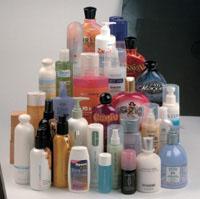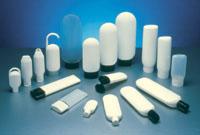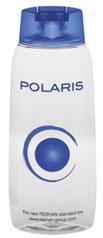|
Not much has changed in the last few years with regard to the form and function of bottles, tottles and caps, which is why those tasked with designing a new package are harkening back to simpler shapes and pared-down presentations. Allowing a product to speak for itself through clear bottles and tubes and coordinated caps continues to be a popular trend.
 |
| M&H Plastic manufactures a wide range of bottles used in the health and beauty care market. |
In the bottle segment, there have been few new shape introductions. “Very little creativity and innovation has been seen in the U.S. market (with regard to bottles),” said Alex Piagnarelli, vice president, sales and marketing, M&H Plastics USA, Winchester, VA, who noted that characteristically European shapes and designs are finding there way into the American marketplace, giving new life to old standard packages. “We are also seeing a resurgence of square bottles that bring back an earlier, more nostalgic time.”
Clear bottles remain at the top of many packaging designer’s most wanted lists. “As more and more products promote natural ingredients and a clean and fresh image…we are seeing movement toward clear containers that can showcase the actual product in the best light,” said Piagnarelli. “So PVC, PETG and PETE containers seem to be more in demand lately.”
“We’re getting more requests for natural, or semi-cloudy, plastic pumps closures and bottles,” agreed Jenifer Brady, vice president, sales and marketing, Brad-Pak Enterprises Inc., Garwood, NJ. She added that there continues to be more of an emphasis on product rather than package. “Formulations have grown increasingly colorful and to showcase the colors, manufacturers have continued to turn to PET plastic, because it looks so high-end, you can’t tell if it’s glass or plastic until you touch it.”
“A lot of companies want to convert their glass packaging to plastic bottles and jars, so there is a big demand for packaging that resembles the look and even the feel of glass, but has all the benefits of plastic,” said Dave Spence, president and chief executive, Alpha Plastics, St. Louis, MS.
Thick-walled PET bottles are an affordable alternative to glass bottles with intrinsic benefits. “The outstanding advantages compared to glass bottles are break resistance (will not fracture when dropped) and flexibility in production, regarding different shapes and colors,” said Dr. Matthias Rebhan, managing director, Rebhan GMBH & CO. KG, Stockheim, Germany. “Additionally, co-extrusion blow molding can be used to produce multi-layer bottles for a highly aesthetical impact and/or for increased compatibility with filling and barrier properties.”
 |
| Cosmetic Packaging Group/ O.BERK Co. offers an assortment of stock tottles, as well as bottles and closures. |
Standard Packs—Custom Looks
Standard plastic bottles can be customized in a myriad of ways, through the use of different decorative techniques and by implementing a diverse array of closures and dispensers. “If you want to start small, you should go with stock and a label,” said Steven Nussbaum, director of marketing, Cosmetic Packaging Group, a division of O.BERK Co., Union, NJ. “As you grow, you can begin decorating on the bottle, giving a texture and a certain quality.”
The tottle is becoming an increasingly popular choice over the venerable tube, added Nussbaum. “Tottles are stable to fill and great for smaller orders because they are available as stock packages. Tubes are custom sized and often carry extended lead times,” he said. “The beauty of a tottle is in its ability to stand up on the shelf and the dispensing conveniences it offers when the consumer takes the product home.”
Tottles are a hit with consumers because as Piagnarelli put it, “convenience is still king. By putting product in inverted containers, such as tottles, consumers have immediate access to product when needed, providing quick and easy application,” he said. “We are also seeing a trend toward more tactile resins such as co-extruded HDPE (soft touch) materials that give the package a softer grip. This is particularly true with products designed for application in the shower where wet slippery bottles can be a problem.”
Closures Add an Element of Difference
On the closure side, some of the most in-demand dispensing closures are colorful, sleek and smooth to coordinate with modern shapely bottles. Bi-injection or other forms of adding colors to caps are also a trend, giving two color options and a more versatile look. Two-part closures can be similarly configured. “Adding eye-catching colors and textures have been a trend in the last year and will continue to be a trend in the next year,” commented Vicki Wittmer, market analyst, Berry Plastics Corp., Closure Division, Evansville, IN.
Cosmetic and personal care manufacturers are also clamoring for uniquely shaped dispensing closures with custom looks. “Customers are looking for packaging which offers them a differentiating look versus their competition,” said Dave Lapp, global category manager, Home & Personal Care, Owens-Illinois, Toledo, OH. “Two-color, two-material, hot-stamped and natural are popular, (as well as) bright, vivid colors which pop off the shelf. There is also an increased interest in utilizing silicon valves.”
 |
Brand-Pak’s new bottle offers a
patented neck ring for easy dispensing. |
New Bottle Forms & Functions
Over the years, there have been plenty of design innovations in dispensing caps and closures, but bottle necks have basically remained the same since the 1800s. Now a new bottle with a patented neck ring from Brad-Pak allows a bottle to neatly dispense without a dispenser or even a special closure. The inspiration for the as-yet-unnamed bottle was born out of Brad-Pak’s glass True Pour® bottles which have a 28-430 pour out neck. “We looked at satisfying our customers demands for something new and different and with a precise directional pour,” said the company’s Brady. “The new patented neck ring can be put on any size bottle and uses a standard closure.”
The bottle, available in glass and plastic, is manufactured for Brad-Pak by Plastique Micron of Quebec, Canada, and is ideal for the fragrance and essential oil industries.
 |
The Polaris from Rebhan has a larger label area, improved size impression and easy residue
dispensability. |
The Polaris bottle series, created by Rebhan, is another functional new option. The standard PET series was developed from scratch to feature a larger label area, improved size impression and easy residue dispensability.
The Polaris series consists of two volumes: 250ml and 300ml, according to Dr. Rebhan, who said, “For the future, we are planning to extend the range by 200ml and 400ml versions. All sizes are fitted with an elegantly formed polypropylene cap that can be opened and closed with one hand.”
The injection blow molded PET Polaris range offers crystal clear transparency and a smooth surface, rendering it ideal for use as a shower or shampoo bottle.
 |
| Luxelab Salon’s Blonde-Aid conditioning product is packaged in Havana, a semi-transparent bottle from M&H Plastics. |
Another novel bottle application was seen in M&H Plastics’ partnership with Luxelab Salon, Santa Monica, CA. M&H provided a 200ml semi-translucent Havana bottle and matching cap for Luxelab’s Blonde-Aid conditioning product. “The shape itself was chosen for its capsule-like appearance once it has been filled with white product,” said David Abrams, who along with business partner Jason Lara head up Luxelab Salon. “This gave it a more medicinal edge without looking too pharmaceutical.”
One of the elements the Havana bottle brought to Blonde-Aid was the notion of cleanliness. “We felt that the old idea of having to dip your fingers into a pot style container in the shower was not only unsanitary, but also inconvenient,” remarked Abrams. “The flip bottom cap on the bottom of the bottle provided clean, easy access to the product inside, insuring that it remains unaffected by the users hands and the shower water.”
 |
| DieterBakicEnterprises’ Rebecca bottle is used by Merz Consumer Care for its Tetesept brand of shower products. |
Another bottle, the Rebecca from DieterBakicEnterprises (DBE), was recently used by pharmaceutical and consumer care company Merz Consumer Care GmbH, Frankfurt am Main, Germany, to package its Tetesept brand of shower products. “They needed a bottle suited for the fast moving shower market combined with an innovative and easy to handle closure system,” commented Maximilian Skaupy, manager PR/communication, DBE. “To stress the high profile of their shower range, Sinnendusche used a design-oriented standard packaging system together with the Loop Flip Top for superior dispensing control.”
Bottle making lines are reaping the rewards of technology. Alpha is using vision systems and leak detectors, to improve the quality of the bottles it produces. “Those in-line technologies, coupled with the inherent quality improvements in the blow molding processes we use, have enabled us to identify quality issues and prevent them from become a problem for fillers and end-users,” said the company’s Spence.
Beyond Flip Top Caps
When it comes to caps and closures, Press Open Closures (POCs) are still a top choice. A patented POC from MFV International Corp., Morristown, NJ, opens, dispenses and closes with an easy one-handed motion. “The consumer is always searching for convenience,” remarked Yoshiyuki Takahashi, president and CEO. “POC technology offers significant advantages to other dispensing caps currently in the market; the design is at once ergonomic and user-friendly.”
MVF’s POC is also in tune with the most prevalent closure trend—color. “The two-part design of the POC cap also allows for color-coding,” he said. “The push-button and/or the body of the cap itself can be run in a custom color to match the color scheme of the container or decoration scheme.”
MVF’s POC also features an orienting neck finish design that aligns the push-button with the front of the package, allowing for a smart appeal when products are merchandised on the shelf.
To complement MVF’s POC, Westlake Packaging, Agoura Hills, CA, MVF’s sales agent for the western USA market, developed several bottle designs including a new shape called R2, a PET bottle that morphs from a square shape at the base up to a round shape at the shoulder and matches the diameter of the POC cap.
MVF’s POC can currently be seen on Joico Laboratories’ Spiked Eraser Shampoo, part of the I-C-E line of styling products. “The I-C-E line has a unique urban feel,” said Mary Freeth, marketing director, Joico & ISO, Arcadia, CA. “I-C-E stands for Individual Creative Expression and therefore, our packaging conveys the brand’s identity. Every product from Eraser Shampoo to Gripper Mega Spray Wax incorporates unique, edgy packaging elements.”
Dual chamber packaging that combines two ingredients into one upon being dispensed is becoming increasingly popular. Owens-Illinois recently capped off Procter & Gamble’s Outlast Liquid Makeup with a unique dual-hinge closure. “Facial skin topography is typically uneven. Traditional liquid makeup doesn’t correct unevenness but actually accentuates pores and differing textures,” said Bret Shepherd, senior purchasing manager, Procter & Gamble, Cincinnati, OH. “With Outlast Liquid Makeup, the base coat fills in fine lines and evens skin’s texture creating a more uniform surface for flawless topcoat application. The base coat and the water-based topcoat are designed to be compatible so the pigments form one smooth, flawless layer.”
 |
| Graham Webb International’s Halo bottles are designed by TricorBraun Design Group. |
Decorative Progress Varies Texture Too
In cosmetic packaging, it’s not only form that matters, but also feel. These days, a major emphasis in decorative processing is to make exotic processes more affordable. “Multi-shot injection molding (the ability to mold two materials or colors into an item) is becoming more prevalent,” observed Craig R. Sawicki, executive vice president, design and development, TricorBraun, Clarendon Hills, IL. “This can give the consumer both a visual and tactile experience in a products use as well as a provocative appearance to gain attention on the store shelf.”
“Haptic elements are increasingly important,” said Maximilian Skaupy, manager PR/communication, DBE. “For example, many customers want their packaging covered by a soft-touch finish, the bottle or tottle can have such a form that it invites the buyer to touch and hold the object. Holding a compact for example, becomes almost a sensitive experience. So the satisfaction of all senses will be demanded now on different markets in different sectors.”
“The demand for functional and unique dispensing seems to be the primary driver to package design for both cosmetic and personal care items recently,” remarked Sawicki. “Although the packages’ beauty is still significantly important, it must convey to the user its reason for being. The form must speak to the function, making the function intuitive.”
The growing use of new plastic and polyester materials offer many technical options and easier handling and adaptation during the production phase at reasonable prices, noted Skaupy. “Consequently, they open many more opportunities for realization of the design, especially for the realization of unconventional forms. So design is becoming less constricted by technical limits.”
Amidst a backdrop of rising resin and fuel costs affecting plastic and glass alike, technological advancements are offering increasingly more affordable opportunities for package coating and finishing. “Beautiful and distinct effects can be reached through metallization procedures and finishing options,” said Skaupy. “Effects in matte, shiny, pearl effect, individually or in combination as well as soft-touch finishes, and other surface treatments such as UV, PU, lacquering methods, and laser cuts on glass can be achieved today.”
“The want and need for custom-designed packaging spans all markets,” said Sawicki. “Marketers know that a product’s image is almost always first associated with the package shape and color. A generic package does nothing for brand loyalty.”
The TricorBraun Design Group recently designed a contemporary package for the Halo line of products by Graham Webb International, a division of Procter & Gamble. The Halo bottle is OPET with a PP base cup that was vacuum metalized to appear pearl blue. The overcap is also metallized PP and was designed to fit over a stock CCL disc top cap to give the overall flush appearance.
Skaupy concluded that the treatment sector has become increasingly global. “With respect to country markets, the big players remain France, Germany and the U.S., while China, Brazil, India, Turkey, and Russia are emerging,” he said.
Market Demands
Growth in niche areas such as children’s and teens’ lines have prompted an exponential growth in new packaging. “These are markets that have offered limited products in the past, but never the wide selection of products and sizes that exist now,” noted Alpha’s Spence. “For example, while there have long been products formulated for children’s skin care needs, there has been a recent proliferation of branded skin care products that appeal to youth and teen audiences with new colors and scents. At the same time, kids’ special skin care needs are being recognized in other brands’ emphasis on all-natural, fragrance-free types of products.”
Other active market segments are sun care products and bath and body products, especially shower gels, but none are more surprising than the surging growth of men’s toiletry products. “Men are now pampering themselves almost as much as women,” said M&H’s Piagnarelli.
From a broader perspective, more marketers are looking to international markets for their growth opportunities. As a result, bottle and tottles with ml sizes (as opposed to ounces) are in great demand, noted Piagnerelli. “Bottles that have ml capacities are more attractive to companies that have global distribution channels.”
Manufacturers are increasingly concentrating on core business values of production efficiency, functional and material innovation, and cost effective production as globalized competition is growing more accelerated. The most complex and important issue, contended DBE’s Skaupy, is packaging design and function. “Good design attracts targeted customers and highlights the benefits of a product, representing its soul, its ‘core truth.’ It needs to consider coherency over a number of products and components,” he said. “Special design know-how to guarantee industrialization is needed. Yet, design alone counts little if it cannot be technically realized. Expertise in technical development is required: planning, tooling, production and industrialization processes logistic and other services have to work hand in hand with designers’ creativity.”
|












